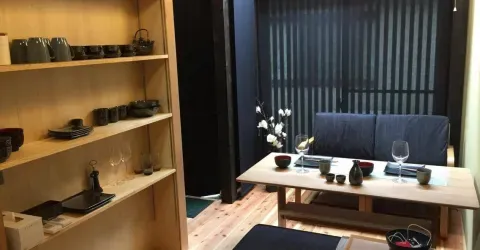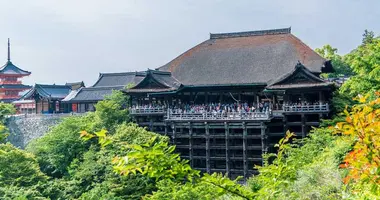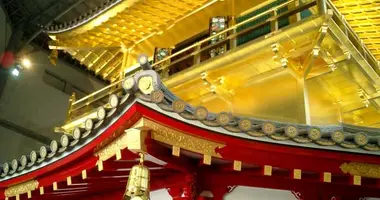Takao Kyoto
Takao 高雄
Takao in the mountains of north west Kyoto is famous for its spectacular fall colors.
Takao is also visited in the hot summer months when visitors can enjoy a picnic and cooling off in the clean water of the Kiyotaki River.
A number of cycle and hiking routes in the woods means the area also attracts mountain bikers and walkers throughout the year.

Kiyotaki River, Takao, Kyoto, Japan

Avenue of cryptomeria trees, Takao, Kyoto, Japan
Takao Temples
Takao is also home to three historic temples: Jingoji Temple, Kozanji Temple and Saimyoji Temple. Both Kozanji Temple and Saimyoji Temple were at one time both sub-temples of the larger Jingoji.
Jingoji Temple was established in 824 and has a number of National Treasures including ancient calligraphy written by the priest Kukai (Kobo Daishi) as well as several important Buddhist statues. Replicas are on show at the temple while the originals are kept at the Kyoto National Museum and Tokyo National Museum.
Kozanji Temple was established at the beginning of the 13th century by the monk Myoe (1173-1232).
Kozanji has the oldest tea field in Japan, where Myoe allegedly planted tea from seeds brought back from China by Eisai, a Zen priest.
Also of interest are the temple's collection of picture scrolls (Choju-jinbutsu-giga) showing animals at play and considered to be Japan's earliest manga. Replicas are on show at the temple while the originals are kept at the Kyoto National Museum and Tokyo National Museum.
The pretty grounds of Saimyoji Temple contain Japan's oldest maki tree (a type of yew) thought to be over 600 years old. The Main Hall has statues of Shaka Nyorai (the historical Buddha), a thousand-armed Kannon and a Fudo Myo-o.

Jingoji Temple, Kyoto, Japan

Choju-jinbutsu-giga, Animal-person Caricatures, Kozanji Temple, Japan
Takao Hiking & Cycling
The hills in Takao are cultivated with cryptomeria trees and walking or cycling below these huge trees can be awe-inspiring. Take the path from Jingoji south along the river through Kinunkei (Brocade Gorge). The walk to the village of Kiyotaki takes about 90 minutes. During the summer on weekends and National Holidays, Kyotoites come to picnic and swim here.

Kiyotaki Valley, Takao, Kyoto, Japan
Takao Dining
A number of restaurants in Takao set out tables on platforms over the river in the summer and autumn months. Toganojaya (Tel: 075 841 4206), near the entrance to Kozanji, has tatami-style rooms overlooking the Kiyotaki River. Shigetsutei (Tel: 075 861 1801), near the entrance to Saimyoji, also has outside tables.

Takao Kanko Hotel, Takao, Kyoto, Japan
Takao Accommodation
There are a number of very upmarket ryokan (traditional Japanese inns) and hotels in Takao. These include Momijiya Ryokan Kyoto - a traditional Japanese inn over 100 years old with fine Kyoto cuisine and western and Japanese style rooms, Momijiya Annex, with open air bath and forest views and Takao Kanko Hotel, an inn adjacent to the Kiyotaki River with Japanese-style rooms. During the summer season there are traditional Japanese dance performances during dinner. (Tel: 075 871 2991).
Takao Access - Getting To Takao
Takao is located on Route 162 (Shuzan Kaido), the winding road that begins at the Golden Pavilion (Kinkakuji), passes the famed stone garden at Ryoanji Temple and Ninnaji Temple, and leads west out of the city to the mountains.
Take the JR Takao Keihoku Line bus to Yamashiro Takao from Kyoto Station (about 50 minutes). The Japan Rail Pass is valid on this bus.
Alternatively take the number #8 Kyoto city bus from either Shijo Station or Karasuma Station and get off at the Takao bus stop. Takao is not within the Kyoto City Bus & Kyoto Bus One-day Pass (500 yen) zone.
From Kiyotaki bus #62 goes to Sanjo Keihan Station and bus #72 to Kyoto Station both via Arashiyama.
From Takao continue on Route 162 to Miyama.

Entrance Stairs, Jingoji Temple, Kyoto, Japan
Takao Map
View Kyoto Temples & Shrines Map in a larger map
Books on Kyoto Japan
Takao in the mountains of north west Kyoto is famous for its spectacular fall colors, outdoor dining and walking.






























